In Photos: Pirate Ship Discovered in the UK
An ancient wreck
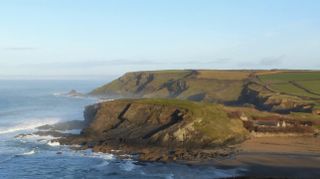
The wreck of the Schiedam is one of many shipwrecks along the rocky and storm-swept at Atlantic coast of Cornwall in the U.K.
The ship sank in a storm in 1684 off Dollar Cove in the Gunwalloe district of Cornwall's Lizard Peninsula.
This photograph shows Gunwalloe Church Cove in the foreground, with Dollar Cove behind it. [Read more about the pirate ship discovery]
A dangerous spot

Dollar Cove – called Jangye Ryn in Cornish – is exposed to heavy waves from the Atlantic.
The shipwreck of the Schiedam has lain in the water, just beyond the rocks of the beach, for more than 300 years.
The ship sank in a storm in 1684, after returning from Morocco with English military stores on board.
Finding artifacts

Historian Robert Felce lives near Dollar Cove and often visits the beach, looking for objects that have washed up from the sea.
Last month he found this 17th-century hand grenade – and he found he found a similar grenade same beach last year.
Both objects were heavily encrusted with scale and debris from the ocean – Felce said he thought the latest find was an ordinary rock, until it broke open and revealed the grenade inside.
Historic warfare

Grenades like this were used in the 17th century, by troops armed with muskets and swords.
Some English soldiers were specially trained to throw them long distances, and they were later formed into the Grenadier regiments of the British Army – a title still used by some regiments to day.
Simple construction
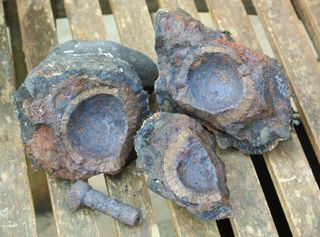
The grenades consisted of a hollow iron shell filled with several ounces of gunpowder. A tube-like fuse filled with gunpowder lead through the shell to the charge inside.
The hand grenades found by Robert Felce at Dollar Cove were made safe by bomb disposal experts from the British Army, who scraped out the gunpowder.
Multi-use ship
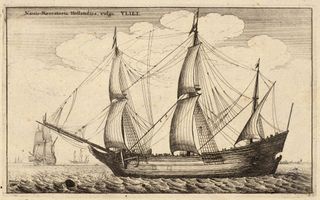
This 17th-century illustration shows a Dutch cargo ship, known as a flyute, similar to the Schiedam.
The Schiedam had been captured by pirates from the Barbary Coast in 1683 – but it was seized by the Royal Navy and used as a cargo ship.
In 1684, the Schiedam was used in of navy convoy carrying military stores from English garrisons returning from Tangiers in Morocco.
But it was separated from the convoy during a storm and sank at Dollar Cove.
Years untouched
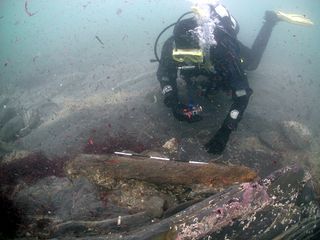
The wreck of the Schiedam lay for centuries on the seafloor of Dollar Cove.
It was rediscovered and identified about two years ago by divers from Cornwall Maritime Archaeology, a private research group that investigates wrecks off the coast of Cornwall for the Historic England agency.
Sign up for the Live Science daily newsletter now
Get the world’s most fascinating discoveries delivered straight to your inbox.
Abundant weapons
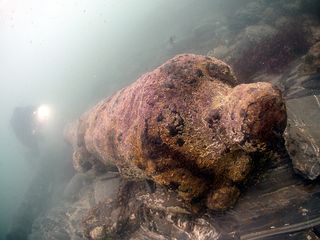
The archaeological divers, Mark Milburn and David Gibbins, have since documented many items from the wreck of the Schiedam that still lie on the seafloor.
They include a total of 11 cannons found so far – thought to have been part of the military cargo carried by the ship stop.
Unidentified objects

Other remains of the shipwreck found on the floor of Dollar Cove include boxes of hand grenades – like the ones found washed up by Robert Felce.
The divers do not know what these round and hollow objects are – it’s thought they may be parts of a bombard, an early type of cannon or mortar that was used to throw stone projectiles at defensive walls.
Nature's help
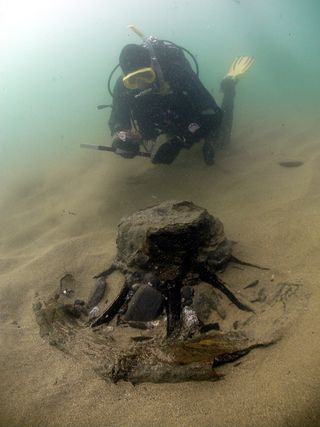
Recent storms along the coast have disturbed the sand that covers much of the shipwreck of the Schiedam.
Milburn and Gibbins visited the wreck again in recent months, and found that even more debris from the wreck could now be seen.
This photograph shows a gun carriage wheel from the ship’s cargo of military stores.
Little structure left

Very few of the wooden parts of the Schiedam remain after more than 300 years at the bottom of Dollar Cove.
Milburn said that each storm that exposed more of the wreck caused some damage to the pieces that are left.
But several iron objects from the ship remain, scattered on the seafloor.
Tom Metcalfe is a freelance journalist and regular Live Science contributor who is based in London in the United Kingdom. Tom writes mainly about science, space, archaeology, the Earth and the oceans. He has also written for the BBC, NBC News, National Geographic, Scientific American, Air & Space, and many others.
